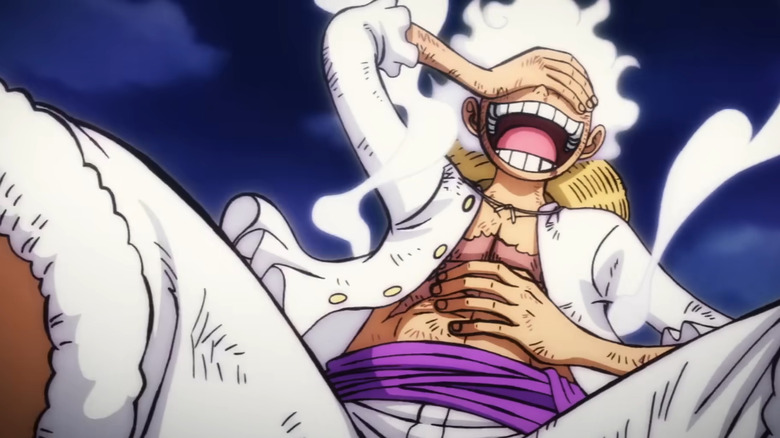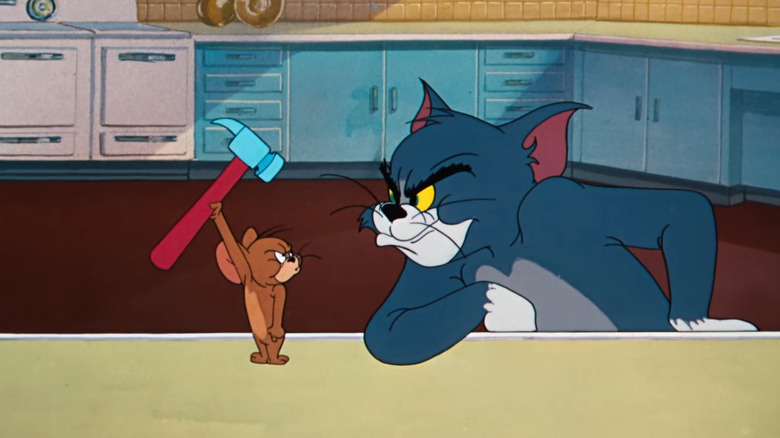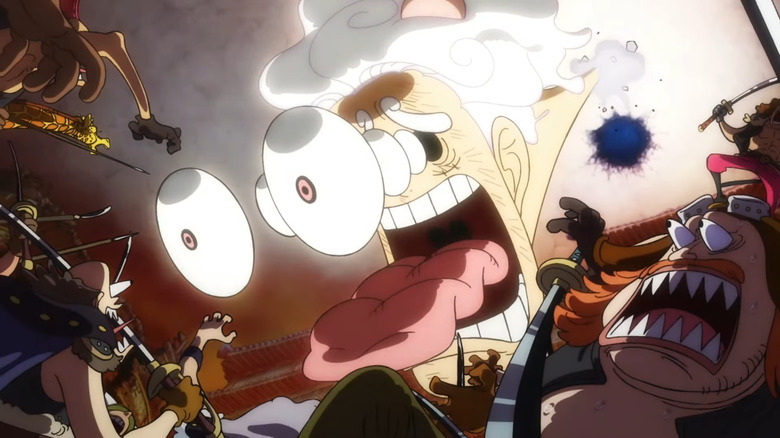One Piece's Big Power-Up Was Influenced By A Classic Hanna-Barbera Cartoon
Anime power-ups are a trope as old as time, bringing excitement to the heat of battle, freshness to the hero (or villain) and their attacks. They also teach young readers and viewers that through training they can grow bigger and stronger — or in the case of Luffy's Gear 5 in "One Piece," they can turn into cartoon chaos gods.
Ever since "Astro Boy" introduced the idea of characters with different levels of power, authors have tried to introduce new and cooler ways to have their characters evolve. Mecha shows like "Mazinger Z" had their giant robots gain upgrades over time. "Sailor Moon" and other magical girl anime added their own spin with the guardians getting boosts to their power while also getting shiny suits. "Digimon" had evolutions that gave characters physical transformations. Of course, there's the seminal anime power-up — the Super Saiyan form from "Dragon Ball Z." Inspired by Bruce Lee, the form became one of the biggest pieces of anime iconography ever, and has become part of American pop culture lexicon.
After over 1000 episodes, "One Piece" reached its own Super Saiyan moment. While we had seen Luffy do "Gear" power-ups before, they were never proper transformations — until now. The latest power-up was a huge and wild moment in both the manga and the anime, but it didn't come without some controversy. Some fans didn't care for the way Gear 5 radically changes Luffy's physicality and turns him into a, well, cartoon character complete with rubber hose animation. But the thing is, Luffy was always more than a bit looney, and Gear 5 was just the right time for its creator to channel a classic Hanna-Barbera cartoon.
When Luffy echoes Jerry
In an interview with Detective Conan creator Gosho Aoyama published in Weekly Shonen Jump magazine and Weekly Shonen Sunday (via Twitter), Eiichiro Oda talked about giving Luffy the Gear 5 power-up and how that was something he always wanted to do. "For the concept, think of it as if I suddenly drew 'Tom and Jerry,'" he said. For the author, what mattered was that he "really want to have fun, and I think that it's okay if people don't like it. I just want to play around with my battles." Indeed, Oda goes on to lament the way manga has shied away from doing "silly expressions that were so characteristic in manga" like "making the character's legs go in circles when they're running" — and he isn't wrong.
Weekly Shonen Jump, where "One Piece" is serialized, has a long tradition of stories unafraid to get goofy with silly cartoonish expressions and imagery like "Dragon Ball" and "JoJo's Bizarre Adventure." In recent years, however, the biggest stories in the magazine have been gritty and horror-inspired action series like "Chainsaw Man," and "Jujutsu Kaisen."
"Nobody draws them anymore even though they're our predecessors' creations who also left many formula we still use," Oda continued. "I want and have decided to have fun, and I feel like I'm finally able to do that. When I was drawing this, I actually had fun."
That's why Gear 5 feels like such a monumental power-up, because the opposite of the traditional idea of a character becoming more serious as they become stronger. Luffy is constantly laughing, bouncing around and changing the reality around him like making the ground rubber and pulling it up to reflect an attack. The way he utterly disrespects and mocks his adversary Kaido during combat — like using him as a jumping rope — is straight out of "Tom and Jerry."
Luffy has always been goofy
As different as Gear 5 may initially seem, it is completely in line with what "One Piece" has done from the beginning in regards to Luffy. After all, this is a kid who has avoided traditional shonen protagonist arcs in favor of having the same dream since the very first episode — and no other goal. He is a character all about freedom, including the freedom to just make up the most random attacks because they look fun, like spinning his legs so fast he floats in the air like an UFO, or entwining his fingers to make a giant net. Back in the early days of the story, Luffy's attacks weren't about being strong, but funny and inventive. Gear 5 feels like the culmination of those ideas, as it is a power-up that is not based on just seriousness or strength, but laughter and smiling.
It is the epitome of Oda's entire career with "One Piece," as his art style has always been a mix of traditional Japanese manga art with traditional American cartoons like "Looney Tunes" and "Tom and Jerry." After all, this is the same anime and manga with a recurring joke about characters' eyes popping out of their sockets for comedic effect — which now feels less like a gag and more like the progression of Luffy's power. Like with most things "One Piece," this is not a reveal that comes out of nowhere, but an inevitability.
Gear 5 is the punchline to a 25 year old joke about a boy with rubber powers, the thing "One Piece" has always been building toward, and it rules.


